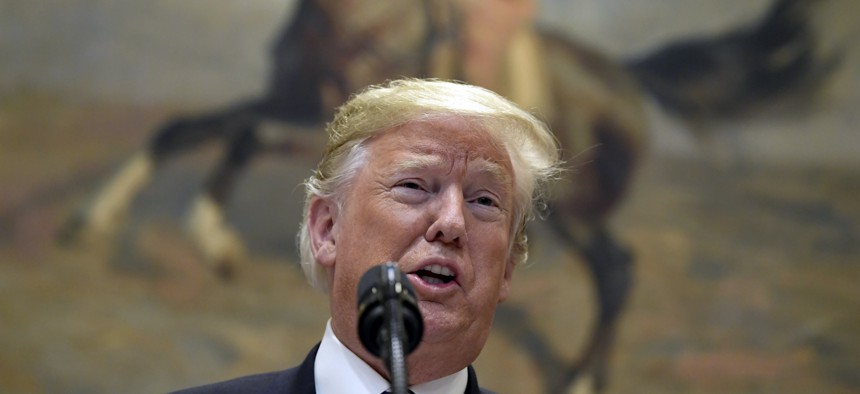
President Donald Trump talks about immigration and gives an update on border security from the Roosevelt Room of the White House in Washington, Thursday, Nov. 1, 2018. AP Photo/Susan Walsh
Trump Sparks Outrage with Claims That Rocks Should Be Treated As Firearms
But there is precedent for firing on rock-throwers on the border. CBP agents have done so on numerous occasions.
Can the U.S. military shoot at migrants who throw rocks at them?
President Trump said he has instructed thousands of active-duty troops sent to the southern border to deter a caravan of Central American migrants to treat the throwing of stones as “a firearm.” But the order has prompted outrage from former senior defense officials who say meeting rocks with gunfire would be an unacceptable use of force under U.S. and international law.
One of the most basic tenets of the law of armed conflict is that the use of force must not be excessive in relation to the military goal—and that principle is reflected across Department of Defense regulations.
But the Pentagon has declined to offer specifics about its guidelines for use of force on the border, while emphasizing that troops maintain the inherent right of self-defense. U.S. troops are restricted by law from conducting law enforcement on domestic soil and, at least in principle, are being sent to the border purely as auxiliary support for the U.S. Customs and Border Protection.
In a tweet, former Joint Chiefs of Staff Chairman retired Gen. Martin Dempsey suggested that the Defense Department will quietly ignore Trump’s instruction. (“When they throw rocks like they did at the Mexico military and police, I say, consider it a rifle,” the president said at the White House on Thursday.)
“Our men and women in uniform are better trained, better equipped, and better led so they meet any threat with confidence,” Dempsey tweeted. “A wasteful deployment of over-stretched Soldiers and Marines would be made much worse if they use force disproportional to the threat they face. They won’t.”
Mark Hertling, a retired three-star Army general, said in a tweet that an order to shoot a rock thrower would be “unlawful.”
“There is no leader in the military - Officer or NCO - who would allow a soldier to shoot at an individual throwing a rock,” Hertling wrote. “They know that violates the rules of engagement, the law of land warfare & the values those in the military believe. It would be an unlawful order.”
Trump on Friday appeared to subtly walk back his instruction, telling reporters, “I didn’t say shoot.”
But there is precedent for firing on rock-throwers on the border. CBP agents have done so on numerous occasions.
In April, an Arizona jury acquitted a CBP agent of murder for the 2012 shooting death of a Mexican teenager who threw rocks at law enforcement officers during an attempt to smuggle marijuana into Mexico. According to court records, 16-year-old Jose Antonio Elena Rodriguez pelted rocks from the Mexican side into the U.S. side in an attempt to distract border agents while two smugglers slipped across the line. CBP agent Lonnie Swartz fired several times on Elena Rodriguez, continuing to fire on him even after he fell, according to prosecutors; Assistant U.S. Attorney Wallace Heath Kleindienst told the court that Swartz “was fed up with being rocked.”
In 2010, a CBP agent shot a 15-year-old Mexican teenager who was peering out from behind a concrete pillar on the Mexico side of the concrete culvert between El Paso, Texas and Juarez, Mexico, claiming that the teen was throwing rocks at him. The agent, Jesus Mesa Jr., had come upon a group of Mexican youths who had made a game of running across the culvert to touch the U.S. border fence.
The FBI cleared Mesa of wrongdoing, but the CBP changed its use-of-force policies in the wake of the incident to urge agents to take cover in response to rock throwing. The current handbook explicitly states that agents “shall not discharge their firearms in response to thrown or launched projectiles unless the officer/agent has a reasonable belief, based on the totality of circumstances (to include the size and nature of the projectiles), that the subject of such force poses an imminent danger of serious physical injury or death to the officer/agent or to another person.”
“Officers/agents may be able to obtain a tactical advantage in these situations, through measures such as seeking cover or distancing themselves from the immediate area of danger,” the policy advises.
Active-duty forces have their own rocky history on the border. In 1997, U.S. Marines shot and killed an American teenage shepherd who the Marines believed to be a drug runner. His death caused an uproar and the Pentagon suspended military patrol of the border in response.
Broadly, U.S. troops operating on the border are limited by the 19th Century Posse Comitatus Act, which would require an act of Congress for the president to wield the U.S. military for domestic law enforcement purposes.
The 2,000 National Guard troops who have been deployed to the border since April can’t make arrests and are only armed in limited “circumstances that might require self-defense”; past National Guard deployments under Bush and Obama have been similarly restricted from law enforcement activities.
The new deployment is thought to be the largest peacetime mobilization of active-duty forces to the border in more than a century—at least 5,200 troops, which the White House says are needed to counter the caravan, still hundreds of miles away from the border. Trump has said that number could go up to 15,000 troops. The main caravan is made up of about 3,500 people, while a second that entered Mexico on Monday numbers about 3,000.
There have been violent clashes with law enforcement in Mexico. Members of the second caravan threw rocks and bottles at Mexican police on Sunday. A Honduran man was killed, apparently struck in the head by a rubber bullet. Trump has described the caravans—made up largely of destitute families seeking asylum in the United States—as “some very tough fighters” who “fought back hard and viciously against Mexico at the Northern border breaking through.”
Some U.S. troops will be deploying with weapons and “are authorized to use deadly force in defense of ‘all persons, foreign or domestic, who are faced with imminent threat of death or serious bodily harm, and where lesser means have failed or cannot be reasonably employed,’” according to Pentagon planning documents reported by the Washington Post.
Although troops are there nominally to do things like provide medical care and transportation support to CBP agents and construct barriers and fencing, Air Force Gen. General Terrence John O’Shaughnessy, the head of NORTHCOM, told reporters Tuesday that there “could be incidental interaction between our military members and migrants.”
“Let me be clear here,” he said. “The U.S. military personnel that are going have very clear guidance that we’ve given them: It’s the standard rules for the use of force. It’s similar to if we were going to any location within the United States, we have these rules in place for a reason.”
The Pentagon is training troops on the appropriate use of force in various scenarios, O’Shaughnessy said, and “we’re working with CBP to have training venues that will work with CBP to ensure that we fully understand each other’s rules for the use of force … to make sure that we are compatible in our operations, together.”
While Trump’s words may not influence U.S. military policy on rock throwers, they have already been used as justification for fatal shootings of rock-throwing protesters by the Nigerian Army.
Videos on social media showed protesters flinging rocks at soldiers who then shot fleeing protesters in the back, sparking public outrage.
On Friday morning, the Nigerian Army responded to the criticism by posting a video of Trump’s speech in which he said that rocks were equivalent to firearms.
“Please Watch and Make Your Deductions,” the Nigerian Army tweet read.




